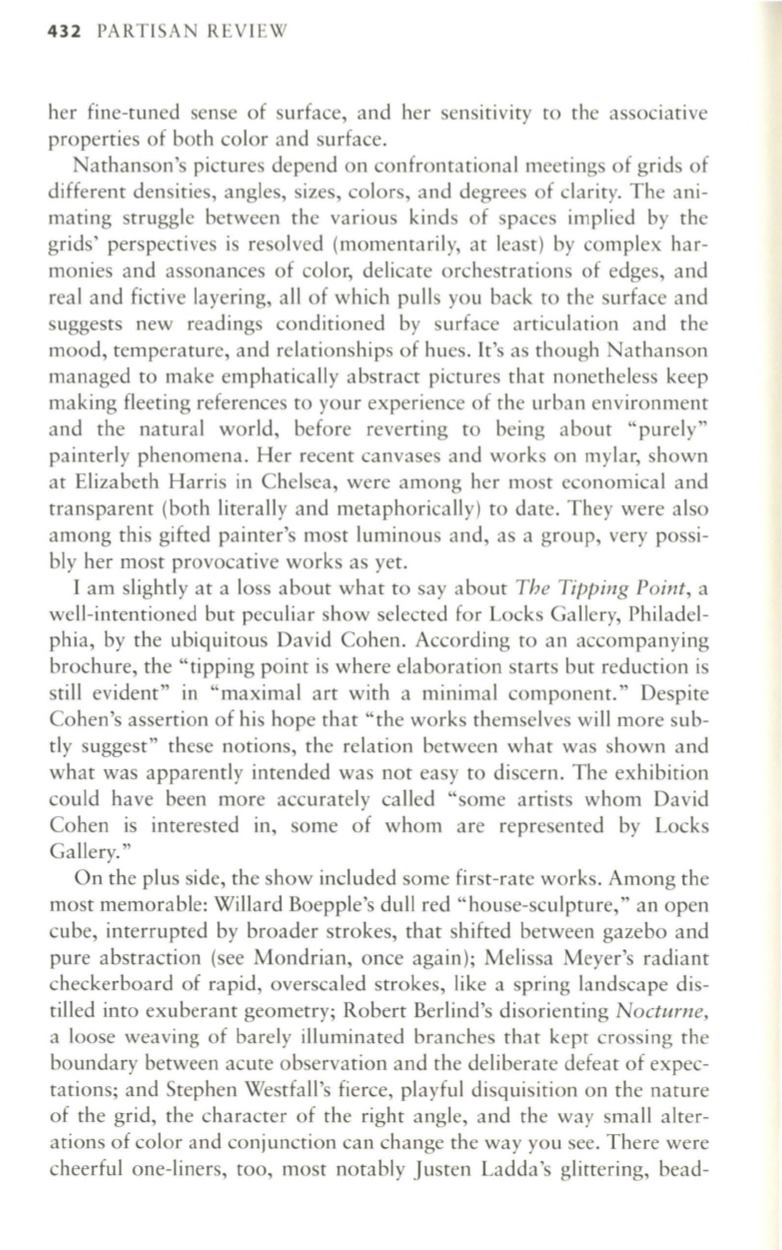
432
PARTISAN REVIEW
her fine-tuned sense of surface, and her sensitivity to the associative
properties of both color and surface.
Nathanson's pictures depend on confrontational meetings of grids of
different densities, angles, sizes, colors, and degrees of clarity. The ani–
mating struggle between the various kinds of spaces implied by the
grids' perspectives is resolved (momentarily, at least) by complex har–
monies and assonances of color, delicate orchestrations of edges, and
real and fictive layering, all of which pulls you back to the surface and
suggests new readings conditioned by surface articulation and the
mood, temperature, and relationships of hues. It's as though Nathanson
managed to make emphatically abstract pictures that nonetheless keep
making fleeting references to your experience of the urban environment
and the natural world, before reverting to being about "purely"
painterly phenomena. Her recent canvases and works on mylar, shown
at Elizabeth Harris in Chelsea, were among her most economical and
transparent (both literally and metaphorically) to date. They were also
among this gifted painter's most luminous and, as a group, very possi–
bly her most provocative works as yet.
I am slightly at a loss about what to say about
The Tipping Point,
a
well-intentioned but peculiar show selected for Locks Gallery, Philadel–
phia, by the ubiquitous David Cohen. According to an accompanying
brochure, the "tipping point is where elaboration starts but reduction is
still evident" in "maximal art with a minimal component." Despite
Cohen's assertion of his hope that "the works themselves will more sub–
tly suggest" these notions, the relation between what was shown and
what was apparently intended was not easy to discern. The exhibition
could have been more accurately called "some artists whom David
Cohen is interested in, some of whom are represented by Locks
Gallery."
On the plus side, the show included some first-rate works. Among the
most memorable: Willard Boepple's dull red "house-sculpture," an open
cube, interrupted by broader strokes, that shifted between gazebo and
pure abstraction (see Mondrian, once again); Melissa Meyer's radiant
checkerboard of rapid, overscaled strokes, like a spring landscape dis–
tilled into exuberant geometry; Robert Berlind's disorienting
Nocturne,
a loose weaving of barely illuminated branches that kept crossing the
boundary between acute observation and the deliberate defeat of expec–
tations; and Stephen Westfall's fierce, playful disquisition on the nature
of the grid, the character of the right angle, and the way small alter–
ations of color and conjunction can change the way you see. There were
cheerful one-liners, too, most notably Justen Ladda's glittering, bead-


